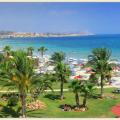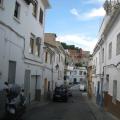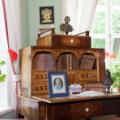Brotherhood of the Brest diocese. The meaning of the Brest diocese in the Orthodox encyclopedia is a tree. Khmelevsky Spaso-Preobrazhensky Monastery
Established by the decision of the Council of Bishops of the Russian Orthodox Church in 1990 and the decision of the Synod of the Belarusian Orthodox Church dated February 6, 1990. It covers the territories of 8 districts of the Brest region and consists of 8 deanery districts - Brest, Berezovsky, Drogichinsky, Zhabinkovsky, Kamenetsky, Kobrinsky, Maloritsky and Pruzhany. By the time of its establishment, there were 79 parishes in the Brest diocese. There were no monasteries.
Until the middle of the 12th century, the Brest (in the annals - Beresteyskaya) land was part of the Turov principality, where already in 1005 there was an Orthodox diocese. From the middle of the 12th century, the Orthodox Christians of the Beresteyshchyna were fed by the Vladimir-Volyn bishops, who sometimes bore the title of "bishops of Vladimir-Volyn and Berestey". In Berestye, at the church of St. Nicholas (the territory of the modern Brest fortress), the residence of bishops was located (according to the documents "Brest Russian See"). Here in 1590, 1594, 1596 the councils of Western Russian bishops were held.
After the conclusion of the Brest Church Union in 1596, the vast majority of parishes and monasteries were subordinated to the Lithuanian-Novograd Uniate Metropolis. In 1765, the Brest bishopric was established (as part of the Vladimir Uniate diocese), since 1798 - an independent Brest Uniate diocese (partially in 1808, and since 1828 completely became part of the Lithuanian Uniate diocese). A few Orthodox parishes were fed at different times by the bishops of the Lutsk, Metropolitan of Kiev, Belorussian (Mogilev) and Minsk dioceses. By 1787, the Brest monastery of St. Simeon the Stylite remained in Orthodoxy (since 1798 an archimandry was established here) and 4 monasteries in the Bialystok region.
After the reunification of the Uniate Diocese of Lithuania with Orthodoxy on January 22, 1840, the Brest Vicariate of the Lithuanian Orthodox Diocese was established. In 1900, by the decision of the Holy Synod, a part of the Lithuanian diocese was formed into an independent one with the title of bishop "Grodno and Brest".
In 1921-1939, eight deaneries of the Brest region were part of the Polesye diocese as part of the Polish Autocephalous Orthodox Church. During World War II, a vicar see of Brest was created within the Autonomous Ukrainian Orthodox Church of Moscow jurisdiction. The first post-war bishop was Paisius (Obraztsov, 1944-1945), from February 14 to September 1945 - Onesiphorus (Ponomarev) with the title "Bishop of Brest and Pinsk". In 1946, Archbishop of Minsk and Belarus Vasily (Ratmirov) temporarily ruled the diocese, in 1948-1949 Bishop Paisiy (Obraztsov), in 1950-1951 - Sergiy (Larin) with the title "Bishop of Grodno and Brest". In 1952 -1989. Bishops were not appointed to the Brest cathedra; the parishes were fed by the ruling bishops of the Minsk diocese.
The revival of the church life of the diocese began with the restoration of those returned by the state and the construction of new churches.
In 1991, the first parish schools of the Law of God for children and adults were opened in Brest, Vysoky, Drogichin, Bezdezh, Chernavchitsy.
In September 1993, a visit His Beatitude Basil Metropolitan of Warsaw and all Poland. The Divine Liturgy was celebrated in the chapel of the Monk Martyr Athanasius, hegumen of Brest.
In 1994, a chapel was consecrated on the grave of soldiers who died in the war in 1812 in the village of Poddubnoye, Pruzhany region.
In July 1995, His Holiness Patriarch Alexy II of Moscow and All Russia visited the diocese. His Holiness bestowed a blessing on the founding of a monastery at the site of the martyrdom of the Monk Martyr Athanasius, hegumen of Brest in the village of Arcadia, Brest region (founded in 1996). In the village of Kamenyuki, Kamenetsky district, the Patriarch met with the clergy of the diocese, regional and district leadership.
In 1996, an international scientific and theological conference was held in Brest, dedicated to the memory of the Monk Martyr Athanasius, hegumen of Brest and the 400th anniversary of the Brest Councils of 1596. Among its participants were the Patriarchal Exarch of All Belarus; Archbishop of Bialystok and Gdansk Savva; Bishop Konstantin of Tikhvin, Vicar of the St. Petersburg Diocese, Rector of St. Petersburg Academy of Sciences; Bishop of Lviv and Drohobych Augustine; bishops of the Belarusian Orthodox Church.
In 1997, the brotherhood "Ascetic" was created in honor of the Monk Martyr Athanasius of Brest, under the diocesan administration (spiritual trustee - the ruling Bishop of Brest and Kobrin John). The Brotherhood is engaged in works of mercy and charity, missionary and spiritual and educational work among young people, the distribution of Orthodox literature, and the creation of libraries. Since 1998, the Brotherhood has been publishing the information and educational newspaper "Dukhovny Herald" with a circulation of 5,000 copies.
In 1998, a sisterhood of mercy was formed in honor of the Monk Martyr Athanasius of Brest at the Brest St. Nicholas Church (confessor Priest Peter Mirochnik). The Sisterhood provides spiritual, educational and practical assistance to patients in the regional oncological dispensary, the children's orphanage in Brest, wheelchair users, and takes care of the nursing home.
Since 1999, hospital rooms-chapels have been functioning at the Brest railway and city hospitals, in the district hospital of the city of Zhabinka, in the regional oncological dispensary (since 2001): Sacraments and rites are performed for patients, conversations are held.
In 1999, the Spaso-Preobrazhenskaya Men's Hermitage was founded at the temple in the village of Khmelevo, Zhabinka District.
Since 1999, missionary work has been purposefully carried out, organized in information, spiritual and educational, apologetic directions. Spiritual and educational articles are published monthly in the newspaper "Evening Brest", in the TV program "TV-Bug", the program "School of Piety" is broadcast weekly (Archpriest Vyacheslav Mandrik); on local television in the city of Drogichin, the Blagovest program is broadcast weekly (hosted by Archpriest Ioann Pinchuk); in Kobrin the clergy of the deanery are preparing a TV program "The Road to the Temple". On Brest radio, the program "Faith, Hope, Love" is played weekly, in Malorita on the regional radio - "Catechism Program". Meetings are held with soldiers and commanders of the Brest military units, with conscripts from high schools.
Prisoners of ITK-SIZO No. 7 of Brest are spiritually nourished, a prayer room has been created here, the Sacraments are performed, and conversations are held.
Educational work outside the church is carried out in 61 Sunday schools, where 3445 people study. 28 parish libraries have been opened, 9 of them are at churches, 19 at Sunday schools.
In November 1999, a photo exhibition "Orthodox Belarus" was held in Brest, dedicated to the 2000th anniversary of the birth of Christ.
In 1999, the newspaper "Brest Diocesan Vedomosti" began to be published (in 2001 it was transformed into the magazine "Christian Time"). In 2002, the publication of "Brest Diocesan Vedomosti" was resumed.
In 2000, the Sophia Brotherhood was established at the Holy Christ and Nativity Parish of Brest, lectures and talks are held with children, students of secondary specialized educational institutions, spiritual and educational talks in hospital chapels, organizes Orthodox libraries in hospitals, courses in religious studies for teachers.
In 2001, an initiative group for the care of oncologically ill children and orphans was created under the diocesan administration (confessor Priest Anatoly Medvedyuk). The group works in the social orphanage of Brest, cooperates with the charitable organization "Children in Need".
In 2001, the construction of buildings under convent in honor of Christmas Holy Mother of God on the Hospital Island of the Brest Fortress.
In June 2001, His Holiness Patriarch Alexy II of Moscow and All Russia visited the diocese. His Holiness consecrated the newly built Brest Holy Resurrection Cathedral, a temple-monument of the Great Victory in the war of 1941-1945 (the builder is the rector of the temple, a veteran of the Great Patriotic War, one of the oldest clerics of the Belarusian Exarchate, Archpriest Evgeny Parfenyuk), and the garrison St. Nicholas Church in Brest fortress-hero.
History of the Brest Vicariate
The Brest vicariate (bishopric) of the Lithuanian Orthodox diocese was established by decree of the Holy Synod of the Russian Orthodox Church dated 01/22/1840 in connection with the church and administrative reorganization after the reunification of the Uniates with Orthodoxy. It spread to the territory of the Grodno province (modern Brest and Grodno regions) and the Bialystok region (now Poland).
The vicariate was divided into 16 deaneries: Grodno, Skidel, Brest, Vysokolitovskoe, Kamenets, Pruzhany, Antopol, Slonim, Polesye, Kosovo, Kobrin, Volkovysk, Lida, Novogrudok and 3 deaneries in the Bialystok region on the territory of the Grodno province. In 1842, 304 churches operated on the territory of the vicariate, there were the Bytensky Holy Trinity (in 1844 transferred to Zhirovichi), Grodno Boriso-Glebsky, Supraslsky Annunciation, Zhirovichsky Holy Assumption, Grodno female Nativity of the Virgin, Torokansky (closed in 1874) .
The primary task of the vicar bishops was the return to Orthodoxy of the Uniate parishes striving for the bosom of the Mother Church: the arrangement of churches, the provision of the necessary utensils and books, attention to the needs of the clergy. The situation was complicated by the opposition of some of the Basilian monks to church innovations, the facts of the transition of the Uniates to Roman Catholics ("Prozorov's case" (1858), "Kleshchelskaya turmoil" (1859), cases of persecution and murder of Orthodox priests during the uprising of 1863-1864).
In the 1840-1870s, active temple construction was carried out. In 1865, in Brest, the new St. Simeon Cathedral was consecrated (after the demolition of the old church of the same name), where the relics of the Monk Martyr Athanasius, hegumen of Brest, were transferred. In addition, there were churches in Brest: St. Nicholas, Holy Trinity, Bratskaya Nikolaev. In Grodno - St. Sophia Cathedral, the churches of Boriso-Glebskaya (Kolozhskaya), Holy Assumption, Alexander Nevsky, the Nativity of the Virgin, St. Martha, St. Sergius of Radonezh, St. Mitrofan. New churches were consecrated in Slonim, Pruzhany, Kobrin, Vysoky, Bereza and other villages.
From 1867 to 1892 the number of parishes approximately doubled. There were the Zhirovichi Theological Seminary (in 1845 it was transferred to Vilna), theological schools in Zhirovichi, Kobrin and Suprasl (in 1853 it was transferred to Grodno). The activity of Orthodox brotherhoods - Brest St. Nicholas, Slonim Preobrazhensky - has been restored; in 1882 the Grodno Sofia was established. In 1863, under the chairmanship of Bishop Ignatius of Brest, the work of the Presence began to improve the life of the Orthodox clergy. In 1900, the vicariate was transformed into the diocese of Grodno.
The bishops of Brest were vicar bishops of the Lithuanian and Vilna archbishops. The residence was the Zhirovichi Holy Assumption Monastery, and since 1848 - Grodno Boriso-Glebsky. The first vicar Orthodox bishop of Brest was Anthony (Zubko, 1839-1840), who signed the Council Act on the reunification of the Uniates with Orthodoxy. His successors were Bishops Mikhail (Golubovich, 1840-1848), Ignatius (Zhelyazovsky, 1848-1870), Evgeny (Shereshilov, 1870-1875), Vladimir (Nikolsky, 1875-1877), Iannuary (Voznesensky-Popov, 1877-1879) , Donat (Babinsky-Sokolov, 1879-1881), Abraham (Letnitsky, 1881-1885) Anastasy (Opotsky, 1885-1895), Joseph (Sokolov, 1891-1897), Joachim (Levitsky, 1897-1900), who became the first Bishop of the newly created diocese of Grodno.
The resumption of the vicariate took place in March 1941 after the reunification of Western Belarus with the BSSR, when, by decree of the Moscow Patriarchate, the parishes of the Brest region were transferred from the Polessye diocese to Grodno with the establishment of the Brest vicar chair with the title of the ruling bishop "bishop of Brest, vicar of the Grodno diocese." Archimandrite Venedikt (Bobkovsky) of the Zhirovichi monastery was consecrated Bishop of Brest, who remained in the chair until April 1942, with residence in Zhirovichi.
With the outbreak of World War II, the Brest region (with the exception of the northern regions) was annexed by the occupying authorities to the Reichskommissariat "Ukraine", where the Autonomous Ukrainian Orthodox Church of Moscow jurisdiction headed by Metropolitan Alexy (Gromadsky) operated. Ioann (Lavrinenko, 1941-1944) with the title of "Brest and Kovel" (in 1955-1956 - Bishop of Perm) was elected to the vicar chair of Brest. At the same time, Georgiy (Korenistov, 1942-1944), a protege of the self-proclaimed Ukrainian Autocephalous Church (later Bishop of Lodz and Poznan) also bore the title of vicar "bishop of Brest". In 1944, after the liberation from the German occupation, the Brest Vicariate ceased to exist.
The Sisters of Mercy work together with the Sisterhood in the name of St. Mary Magdalene Equal-to-the-Apostles of the Peter and Paul Church in Bereza, the youth brotherhood and the pupils of the Sunday School at the Berezovskaya CRH named after E.E. Verzhbitsky" and State Institution "Berezovsky TCSON". Participation in church life and activities of the parish:- visiting Sunday school classes; duty at the operating temple;
- participation in all Divine services related to the commemoration of the soldiers-internationalists who died in Afghanistan; visiting and congratulating their families on the holidays of Christmas and the Resurrection of Christ;
- participation in events dedicated to the taking of the oath by young soldiers, held in the spiritual and patriotic complex;
- conducting educational conversations with parishioners, pilgrims, students and teachers of cadet classes visiting the military-patriotic complex and wishing to get acquainted with the history of the emergence of this historical monument and the life of the holy martyr Sergius of Rakvereisky (Florinsky), whose feet this place was consecrated;
- provision of material assistance to large, low-income families and families raising children with disabilities; - before the start of the school year, the action "Help for School" was held (10 families);
- reading the Psalter over the deceased at the request of relatives;
- participation in the fifth regional Easter holiday of culture and spirituality "Light of Orthodoxy";
- participation in the creation of the museum of military glory of the 151st Pyatigorsk regiment and the memory of soldiers who died in Afghanistan;
- participation in prayers in the military chapel;
- consecration of the prayer room in the IUOT No. 3;
- on the day of memory of the faithful princes Peter and Fevronia, participation in the meeting of the youth brotherhoods of the diocese, dedicated to the topic family life, love and fidelity.
- visiting cemeteries on Radonitsa;
- spiritual support for parishioners who deviated into sects, but then returned to Orthodoxy;
- the "Clean Window" campaign - monthly assistance throughout the year to elderly lonely people; (5 families - regularly).
Cooperation with the health care institution "Berezovskaya Central District Hospital named after E.E. Verzhbitsky":
- visits by sisters to patients undergoing inpatient treatment;
- in the chapel of the hospital - reading of akathists to St. Equal-to-the-Apostles Mary Magdalene, St. Great Martyr Panteleimon and the image of the Queen of Heaven, called the Healer);
- "Everything is sweet for children" - congratulations to children in the children's department of the district hospital on the holiday of the Nativity of Christ;
- independent study of the necessary benefits, guidelines to teach the basics of caring for seriously ill people, palliative care and first aid in the framework of self-help and mutual assistance;
- familiarization visits to the sick by the pupils of the Sunday School, who wish to work together with the sisters;
- within the framework of the program "Prenatal Pedagogy" at the antenatal clinic of the district hospital, holding lectures and conversations at the "School of Expectant Mothers" - holding meetings and conversations "In Defense of Life" of patients of the gynecological department of the district hospital with priest Archpriest Georgy Nemshon.
Cooperation with the State Institution "Berezovsky TCSON":
– Confession, Communion, Unction; home delivery of food and medicines, spiritual literature, audio cassettes (every fast and at the request of those in need);
- spiritual and informational education and assistance in the work of the Association of Alcoholics Anonymous (weekly);
- organization of assistance and interaction with the clubs "Gold Placer" (pensioners) and "Mother's Heart" (mothers raising disabled people);
- organization of the circle "Orthodox alphabet" for the clubs "Gold placer" and "Mother's heart";
Cooperation with the State Educational Institution "Nursery Garden No. 8 in Bereza":
- organizing a circle of religious studies and conducting classes with children with the consent of the parents; - creation of an Orthodox corner;
In which institutions does the sisters serve:
- Health care institution "Berezovskaya Central District Hospital" - Bereza, st. Lenina, d. 1;
- State Institution "Berezovskiy Territorial Center for Social Services to the Population" - Bereza, st. September 17, 35
- State educational institution "Nursery-garden No. 8", Bereza, st. Gorina-Kolyada, 15A.
 How to get from Larnaca to Ayia Napa
How to get from Larnaca to Ayia Napa Oliva (Oliva) - a town in Spain on the Costa de Valencia Moorish quarter of Oliva
Oliva (Oliva) - a town in Spain on the Costa de Valencia Moorish quarter of Oliva Pushkin places in Russia
Pushkin places in Russia